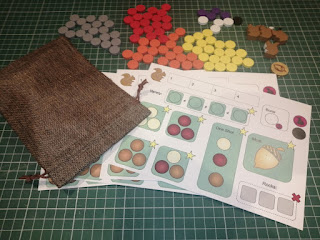A couple of weekends back, I was lucky to be invited to a board game designers' weekend. It was just a small event, held in a private house, with a dozen or so designers attending, with varying levels of experience, design styles and interests. I had been to one of these previously and had a great time, and this one, with a different mix of people, was just as enjoyable and useful, but with a different feel to it.
Most of the time was spent playtesting each other's games, with the aim being to ensure that everyone had reasonably even opportunities to test the games that they had brought. I was able to get tests of both The Artifact and Squirrelled Away, with really helpful feedback and observations from both, meaning I had a fair bit to talk about with the respective co-designers afterwards.
Apart from the playtesting, there was an hour or two spent on lightning game jam exercises after lunch each day. The objective was to team up with someone and create or develop game ideas according to the rules being used that day.
 |
| A game from the Sunday jam. When working this quickly, rough and ready is the thing. |
The first day had us splitting into teams of two and then going through a series of short (about 10 to 15 minutes) spells of development. The first period involved setting some constraints for a game design. Then these constraints were passed to the next team, who had to begin a game design based on these restrictions. After this period, the projects were passed on to the next team to continue the development and so on. Having gone through a few iterations of this, we had a little "show and tell" session where each team discussed the game that they had ended up with.
On the Sunday, things ran a bit differently. There was a table of components available, and everyone chose a batch of those components (maybe a handful of dice, some plastic rods, or a bag of feathers), and then find a partner who has some other components, and then create a game using the combination of components in 15 minutes. We went through four iterations of this, and I was delighted to have created four actually playable games (mostly terrible, obviously, but one was quite a lot of fun) with four different design partners. The debrief session from this was just a general group chat about anything we felt was interesting.
Overall this was a great weekend that completely wiped me out, but left me with so many ideas buzzing around and a great feeling from working with a whole bunch of other people, who all brought their own skills and personality to the process. The high intensity game jams were excellent practice in both working with other designers and in quickly sketching ideas. During the second jam in particular, it felt great to get an idea to the table and start the testing process so quickly. One of the games actually went through some iteration as we got the initial game to the table within about 2 minutes of sitting down.
So, if you are a game designer, and you get the chance to attend an event like this where you can just spend time engaging with and sharing ideas with other designers, I would highly recommend it. If I am invited again, I'll certainly do my best to go along.
This is probably my final post of this year, so I'll just sign off by wishing you a happy Christmas, Yule, or whatever else you might celebrate, even if it is just a day or two off work. I'll see you in 2025, all being well. Have a good one!
















